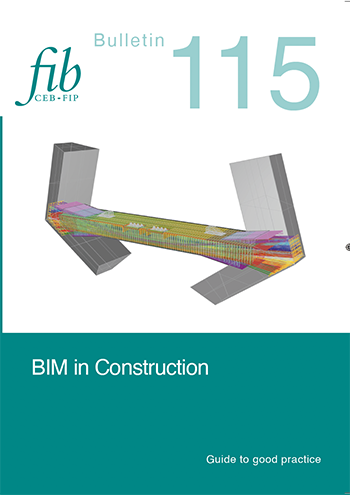BIM in Construction (PDF)
fib BULLETIN NO. 115
Title: BIM in Construction
Guide to good practice
Year: 2025
Pages: 47
Format approx. DIN A4 (210x297 mm)
ISBN: 978-2-88394-190-8
Abstract:
In recent years, Building Information Modelling (BIM) methodology has seen exponential growth in its adoption within the construction industry. Despite its tentative beginnings in a sector traditionally resistant to major changes, the undeniable advantages it offers have made all stakeholders, from designers to builders, including government authorities and facility maintainers, aware of the need to embrace the full implementation of BIM standards in the sector.
Nonetheless, the adoption of BIM methodology presents its own set of challenges. Despite not being a novel approach, BIM has not reached a level of maturity where a universally accepted standard or a singular implementation method has been established. The multitude of BIM use cases is steadily expanding alongside a growing variety of applications, increasing expertise, and the continuous enhancement of software capabilities.
The document management aspect associated with BIM methodology represents its true potential. This entails the ability to centralise the geometry and all attributes associated with an element within a single element that can be shared and interacted with by all stakeholders. This management poses an additional challenge, as it requires clear protocols to ensure that information is exchangeable and exportable between parties. Standardisation within a given market will be much simpler if government authorities establish the standards.
Attempting to compile a comprehensive document on the state of the art of BIM methodology would be a daunting and potentially unproductive task, given that new papers with innovative BIM applications and uses emerge practically every week and with the increasing number of specialised books. Moreover, professionals responsible for designing, constructing, or maintaining structures derive limited benefit from an overly lengthy document that encompasses all possibilities.
Therefore, the objective of Task Group 1.7 (TG 1.7) has been to present concepts that enable readers to gain a basic understanding of the methodology that is sufficiently up-to-date, along with specific examples of its use in various types of structures with varying degrees of complexity. The aim has been to show that BIM usage can range from a specific element of a project to the complete life cycle of a structure, allowing stakeholders to choose what suits their needs best.
The fib Task Group 1.7 is confident that this document will be a useful resource for construction professionals, bringing BIM methodology into their everyday use and thus making the construction industry more modern, efficient, and sustainable.
Gopal Srinivasan, Member of the fib Task Group 1.7 “Construction of Concrete Structures”
Download the copyright page (= list of authors) as a PDF file.
Download the table of contents as a PDF file.



